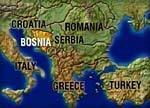SARAJEVO, Bosnia (June 4,2008) - Out of five potential oil fields in Bosnia, the most promising is the one in the Orasje area (northern Bosnia) where huge oil deposits with about 180m barrels worth at today's price about 14bn dollars were found at the depth of about 3,300 meters, Hazim Hrvatovic, director of the Bosnian Geology Institute and lecturer at Tuzla University, told Bosnian media.
He unveiled his thesis about the profitability of further oil prospecting in Bosnia back in 2000 in a very extensive report to the Croatian Academy of Sciences and Arts on the occasion of his election to its Scientific Council for Geological Research. Hrvatovic was one of six Bosnian experts who were directly involved in oil exploration in Bosnia in 1989 when the US company Amoco was given concessions to prospect for oil in the area of the Dinaric Alps [or Dinarides, a mountain range in southeastern Europe] and the British company ECL (Exploration Consultants Limited) in northern Bosnia.
According to Hrvatovic, the British had more specific data to work on than Amoco since in the past prospecting had largely been conducted in northern Bosnia, while the Dinarides region was "discovered" only after Amoco experts began to explore the area. Admittedly, before Amoco arrived in Bosnia, exploration work had already conducted in the area of Glamoc.In 1985, experts from the Croatian oil company INA drilled to a depth of 4,000 meters, but the outcome was negative.
The tests done so far indicate that the largest and most promising oil deposits are concentrated in northern Bosnia. In addition to Orasje, experts from the British company ECL have also designated the areas of Lopare, Samac and Tuzla (Tinje) as being highly promising. The ECL exploratory work went on for full two years and was made possible by a 2.5 million dollar loan from the World Bank. As the ECL preliminary findings showed, northern Bosnia oil deposits amount to 300 million barrels.
"These of course are estimates which could be accurate or not. On my desk, I have a bottle which was filled 20 years ago with oil from a well at Tinja. I tell my students that the oil in the bottle is the only "deposit" which can with certainty be said to exist since everything else are vague, unreliable and as yet unconfirmed estimates," Hrvatovic said.
According to the documentation which Hrvatovic allowed Bosnian media to see, Amoco focussed on the wider area of the Dinaric Alps, from Dreznica to Neum. This is a large site of an area of over 3,000 square meters with a whole series of so-called "oil indicators." Among the most reliable of these indicators is undoubtedly seeping of bitumen out of the ground. Bitumen is a reliable indicator of oil deposits. Bitumen is in fact oil transformed through oxidation. The area of the Dinarides abounds in such indicators and they were crucial for Amoco's decision to focus their exploration on that area. An additional factor was also the discovery of gas on the Croatian side of the Dinaride range following exploration by INA.
Hrvatovic said that in an informal conversation, Amoco experts divulged to him that they were not certain if the Dinarides contained oil or gas deposits since an equal number of indicators point to both. In the Dinarides range, Amoco applied several different exploration methods and they all indicated that there were considerable deposits of either oil or gas at a depth of over 4,500 meters. Same evidence was provided by subsequent seismic research whereby the structure of the earth mantle was subjected to seismic waves. This is considered to be the most reliable pre exploration method.
"Of course, the most reliable method of finding oil or gas deposits is through drilling. Unfortunately, this is also the most expensive method since as a rule only one in ten holes will yield positive results. Drilling is very expensive and at today's prices one kilometre of oil well costs 1 million euros. This means that each oil well in the Dinarides would cost 10 million Bosnian Marks. To prospect the entire area for oil or gas extensively and in a qualitative manner would cost several million Bosnian Marks. However, it would be worth taking a risk since all the evidence points to oil and gas deposits of substantial commercial potential," Horvatic insisted, adding that as a rule oil exploration is expensive, uncertain and risky in economic terms. To illustrate his point he cited the example of Norway where, in a museum, there is a document containing a government decision to end all oil exploration work. Oil exploration cost Norway hundreds of millions of dollars and when they more or less decided to give it up, they discovered oil deposits which are currently among the biggest in Europe.
Exploration work so far, including the prospecting work carried out long time ago under the Austro-Hungarian administration and the more recent exploratory surveys by INA, ECL and Amoco in Bosnia have identified five potential oil fields. According to Hrvatovic, the most promising ones are in the Posavina and Tuzla Cantons largely because they were surveyed most extensively. The area of the Zenica - Doboj Canton with Kakanj as its "epicentre" where a "positive" oil well has been in existence for over 30 years is also of interest. Another prospective area is in the Dinarides stretching from Dreznica to the Bosnian port of Neum. Over a period, a total of 70 holes have been drilled in all five locations with half of them yielding positive results. The highest number of oil wells is in northern Bosnia where oil deposit can be found at a depth of not more than 600 meters. Hrvatovic said that it would not be possible to establish precisely the size of oil and gas deposits on the basis of the surveys conducted so far. This is especially so in the case of the Dinarides range because it is the least explored region. He however believed that the deposits were undoubtedly commercially viable.
"This assessment is definitely valid for Orasje and the Tuzla region. If we are to find enough oil for commercial exploitation, this is where it will be. As for the Dinarides, it would not come as a surprise if instead of oil we find gas there. In any case, exploratory surveys should continue because it is very obvious that the era of cheap oil is over and will never return and that the price of oil will continue to go up," Hrvatovic said.
Under a contract with the Bosnian company Energoinvest the American company Amoco took three years to complete the first phase of its prospecting work in the Dinarides region. Back in 1973 the Executive Council [government] of the Socialist Republic of Bosnia granted Energoinvest concession to start prospecting for oil throughout Bosnia. During the previous 10 years, from 1963-1973, Croatia's INA was the main concessionary and it conducted several extensive surveys especially in northern Bosnia.
However, the first surveys aimed at finding oil reserves go back much further to the time of the Austro-Hungarian administration in Bosnia. The first potential oil field was found on Mt Majevica near Tuzla exactly 100 years ago, in 1898.
The Amoco exploration cost about 7.5 million Bosnian Marks and the American company bore the entire cost. In return, Energoinvest agreed to give Amoco bidding priority for potential commercial exploration contract.
Energoinvest Assistant Director General Ibrahim Bosto told Bosnian media that Energoinvest keeps only a small part of Amoco's documentation on its surveys in the Dinarides. The full version of its very extensive and detailed report is kept in the Bosanski Novi Oil Refinery. Bosto is confident that the refinery's Russian buyers will not procrastinate in handing over the documentation which can be used as a basis for further explorations. Bosto said that new surveys would be launched in partnership with a big foreign company which will be prepared to share the risk of expensive research.
In the 1990s, Amoco (American Oil Company) was the sixth largest oil company in the world with diverse businesses in 40 countries. Amoco experts prospected for and found oil and gas in Russia, Brazil, Egypt, Norway, Venezuela and another 12 countries where they had concessions for many years. Amoco was an independent company for full 100 years until in 1998 it merged with the largest oil company in the world - British Petroleum under whose umbrella it still operates.
.
Wednesday, June 4, 2008
Subscribe to:
Post Comments (Atom)







No comments:
Post a Comment